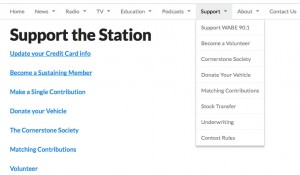Wabe vs The New York Times: The Ad Wars
Intro
When you first sign on to Wabe.org, it seems like any other news source. It has everything that makes up the basic formula for a news site: headlines, pictures, and news categories. However, when you then visit NYTimes.com, the difference is clear. Besides the basic formula, the site’s prominent ads and advanced page design make it obvious that the budget and outreach of the NYTimes is far greater than that of the local NPR station, Wabe. According to “How Americans Get TV News At Home” 71% of Americans watch local televisions news versus the 38% that get their news from national cable networks (Olmstead). So if a significantly larger amount of people are supporting their local news sources over national sources, why do news sources like The New York Times have more money to spend on web design and outreach than our local sources? Also, if The New York Times can afford to upkeep its unique web design, then why do they push their consumers more than Wabe for monetary support?
Background

Wabe’s support options | Learn more here
The New York Times was created in 1851 and has since become one of the country’s oldest and most prominent news sources, boasting a number of 1.09 million digital subscribers in late 2015 (Statista).
Wabe is a local NPR station in Atlanta that focuses on local news. While it’s 88 fluctuating subscribers as of March 2016 aren’t much, they have innovative ways for consumers to support them (“Wabe Atlanta Subscribers 90 Days Stats”). These ways include volunteering, monetary donations, and donating your vehicle.
Image
Wabe users get exactly what they came for. The simple and easy to use interface has the basic features of a news source with simple headlines and accompanying pictures.

Wabe’s simple interface | Learn more here
The site’s menu bar categorizes the website by news source (Radio, TV, Podcasts) and site information (Support, About Us, Contact). There are simple ads on the sidebars and a small button in the top right corner for donations and link to Wabe social media accounts.
On The New York Times’ website, the consumer has a completely opposite experience. The layout of the website is made to resemble an actual newspaper, honoring the paper’s history, and loading the page with information. The black and white font further establishes the newspaper theme, but unlike Wabe, not only pictures, but also article previews accompany the headlines. What stands out the most on the site is the brightly colored ads that are made to draw the reader’s attention.

Brightly Colored Ads urging subscriptions | Learn more here
Advertising and Ad-Blocking
The New York Times has a vastly different approach to having ads on their website than Wabe. In recent years, sites like Facebook and Google have been using consumer-tracking technology to strategically target ads to consumers based on their interests (Komando). Click <a href=”https://sites.gsu.edu/lwong9/2016/03/25/annotated-bibliographies-7-8-9-and-10/”>here</a> to learn more about consumer activity tracking under Annotated Bibliography 8. The New York Times has followed suit and started using this method to pack ads into any available corner on their site.
While this may help them financially, many users have started using ad blocker apps to avoid overwhelming ads. The New York Times has specifically asked its readers not to use these apps in order to maintain this method of financial support (Singleton).
Though Wabe is a much smaller news source, they do not utilize ads as much or as advanced as The New York Times. Their simple interface allows the user to access information without encountering tons of ads and donate in unique ways when they decide to.
Conclusion
As a global leader in news, The New York Times has a lot to maintain. Their millions of readers expect nothing but the usual, which for them, is the best. Their global outreach and digital accessibility makes for an expensive upkeep, meaning users are forced to deal with ads and harassment about subscriptions to make up for it. Wabe’s simple interface exemplifies their establishment. Consumers are met with minimal ads and less pleas for support because they are small enough to maintain themselves through their population of subscribers, minimal ads, and donations.
Works Cited
Komando, Kim. “Facebook is watching and tracking you more than you probably realize.” USA Today.
USA Today. 18 March 2016. Web. 24 March 2016.
Olmstead, K., Jurkowitz, M., Mitchell, M., and Enda, J. “How Americans Get TV News at Home.” Pew
Research Center. Pew Research Center. 11 October 2013. Web. 30 March 2016.
Singleton, Micah. “The New York Times is testing pop-up ads asking users to disable ad blockers.”
The Verge. Vox Media Inc., 7 March 2016. Web. 25 March 2016.
Statista. “New York Times Company: digital subscribers.” Statista. Statista. 2016. Web. 30 March 2016.
“Wabe Atlanta Subscribers 90 Days Stats.” VidStatsX.com. VidStatsX. 2016. Web. 1 April 2016.
